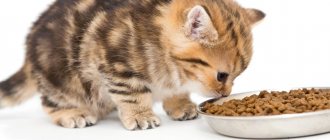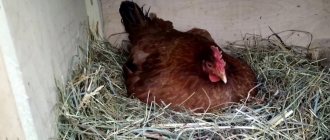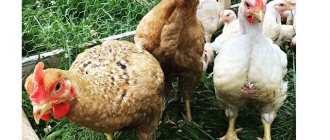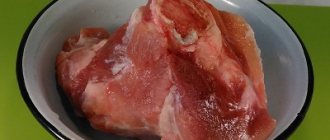Broiler chickens raised at home are an excellent source of tasty, juicy and environmentally friendly meat, which cannot be compared with the products of poultry farms, where various chemical additives and antibiotics are used for feeding.
The opinion that broilers are difficult to raise without hormonal supplements and antibiotics is erroneous. Despite the fact that broiler chickens are much more sensitive to various diseases than, for example, ordinary village laying hens.
In this article we will look at all the nuances and features of feeding broiler chickens, and you will understand that you can raise such chickens on absolutely natural feed.
Features of broilers
The fattening period, from the first day to slaughter, does not exceed 2.5 months. Broilers grow really very quickly and by the indicated age their weight reaches 2.5-3 kg. If we compare it with egg-laying chicken, from which the food product is obtained only after 5-8 months, then during the same period 2-3 generations of broiler chickens can be raised.
On the one hand, it is very convenient and profitable. But on the other hand, raising broilers is not the easiest process, since achieving full productive qualities in a short period of time is possible only with proper feeding, maintenance and the absence of diseases.
Diseases are a separate issue. The immunity of broiler chickens is weak. You need to monitor the health of your livestock very carefully! Do not neglect vaccinations and take action quickly.
Due to the rapid gain of muscle mass, they require a special diet - feed should be high in calories due to the increased percentage of protein in their composition.
The conditions for keeping broilers also have their own specifics. Recently, poultry farmers increasingly prefer the cage method. Its advantages are obvious:
- per 1 m2 you can place much more birds than with the floor method;
- care and feeding are simplified, which has a positive effect on final productivity;
- provides the possibility of year-round cultivation.
Aviary keeping is suitable only for the summer period and subject to warm weather
Fattening broilers longer than the recommended period is not economically profitable. They will not gain much weight, but they will eat a lot of food. Overexposure also threatens various health problems. The mortality rate increases significantly, and the quality of meat decreases.
What not to feed
Healthy broiler chickens have an excellent appetite, so they will eat whatever is offered to them. But this does not mean that they are allowed to give everything: some foods can cause digestive and health problems.
You cannot feed broilers with low-quality food: spoiled, moldy or rotten. Also, you should not give them raw potatoes, which may contain solanine. This substance can cause poisoning and even death of birds, so you should not take risks.
It is also not recommended to feed beet roots and tops - they have a laxative effect. In broilers, the vegetable can cause diarrhea. There is no need to feed fatty or sweet kitchen scraps or fruits to fattening birds: they lead to the accumulation of fat and not muscle mass, as needed.
Basic nutritional requirements
To achieve the full productivity inherent in the genes from a cross, it is necessary to provide the bird with proper nutrition. The most important component in the broiler diet is amino acids . Their role is enormous and, according to degree of importance, is divided into:
- Feather growth.
- Increase in muscle mass.
- The brisket comes out.
- Carcass fat content.
That is, the lack of amino acids primarily affects the feathers. Afterwards, the daily gain decreases, the weight of the brisket decreases and, as a result, the fat content in the carcass drops to minimum values.
The loss of feathers in the absence of parasites is a consequence of violation of feeding standards. Most often, the reason lies in a lack of sulfur, in rare cases – in stress
The yield of brisket is most influenced by sulfur-containing amino acids: methionine and cystine, especially at the final stage of fattening, since there is an additional need for them due to the growth of feathers.
When choosing or preparing feed mixtures, you need to take into account the percentage of amino acids per unit of feed. Another important indicator is the speed and total volume of consumption, which depend on its form. The best results are achieved when using granulated feed. With fine grinding, food is poorly eaten, with coarse grinding, it is digested more slowly.
Making feed yourself gives slightly lower productivity indicators than using high-quality industrial ones. But this approach is economically beneficial if the farmer grows some of the products himself. When you have to buy all the ingredients to create the right diet, it makes sense to analyze the total physical costs (for preparation and storage) and the cost of feed. In some cases (when purchasing at wholesale prices or at a discount, with a small population or with the high cost of individual components in some regions), it is advisable to give preference to ready-made complete mixtures.
Broilers should always have food available, the maximum interval between feedings is no more than 6 hours (at night). The bird must be provided with round-the-clock access to clean drinking water.
Breed selection
For small-scale farming of broiler chickens in the country, it is better to choose chicken breeds based on their general type of utility. The exception is raising broilers as a business; here, with certain investments in premises and equipment, it is advisable to choose the most intensive breeds.
Broiler chickens are specially selected chicken lines characterized by much faster daily growth than purebred chickens and lower feed consumption per 1 kg of body weight.
By growing quickly and achieving significant weight in a shorter time, broilers become relatively cheap to produce. The following broiler breeds are often used for meat production:
- Ross 308
- Ross 508
- Ross 708
- Ross PM3,
- Cobb 500
- Hybro G+,
- Hybro PN+,
- Flex,
- F15,
- JA57.
According to reviews, the most popular broiler breeds for home growing technology are:
- Cobb 500,
- Ross 308,
- Flex.
Broilers were bred from the White Rock chicken line, which was female, and the Cornish line, which was male. To obtain broiler product lines, lighter mother breeds are used, connecting them with heavier males.
There is no perfect broiler line. Each breeder has his own way of using the potential of his herd to achieve maximum profit. Some may achieve high growth in one broiler line and others in another.
It is recommended to purchase broiler chickens (day-old or grown-up) from incubators.
Broiler chickens must have the following characteristics:
- fast growth rate;
- rapid achievement of the peak of average daily weight gain with low fatness;
- high slaughter productivity;
- good feed utilization and low consumption per 1 kg gain;
- ideal muscles of the chest, thighs;
- white plumage with white or yellow skin;
- fast plumage.
When wanting to buy chickens from the most intensive broiler lines that are more suitable for farm conditions, it is often forgotten that their growth potential is very high. This broiler requires:
- special living conditions;
- appropriate feeding;
- chicks quickly react to an unfavorable environment.
Mash recipes
Mash is the most popular type of feed in households. Some poultry farmers take everything to prepare them: table scraps, spoiled food, grass, inexpensive grains. Others prefer to use one main ingredient, making up up to 70% of the bird's diet, combined with supplements to supplement vitamins and minerals.
Raising broilers mainly on wheat ensures high taste of meat. Corn gives good daily growth. Potatoes significantly reduce fattening costs.
However, an incorrectly prepared diet has a negative impact on the overall yield: the mortality rate increases, the growing time is delayed, and the nutritional value of meat products decreases. As a result, instead of saving, you end up with a loss.
The first feeding is carried out immediately after the chicks have hatched and dried out.
From the first day, small chickens are given a hard-boiled egg. Starting from the 3rd day, add low-fat cottage cheese, finely chopped grains, herbs and vegetables. From the 5th – minerals are introduced. Meal or cake and root vegetables are added to the diet of week-old chicks. After the 10th day, eggs are removed from the diet.
Wet mash is given to birds older than 3 weeks.
The use of mash prepared according to the correct recipe helps reduce the cost of commercial feed and has a beneficial effect on all productive indicators.
The proposed recipes for the growth and finishing periods are based on publications on farming forums and methodological recommendations for raising broiler birds per 1 head per day (the final nutritional value for each of the three options is approximately the same):
| Option 1 | Option 2 | Option 3 | |||
| Products | Quantity, g | Products | Quantity, g | Products | Quantity, g |
| Crushed | 20 | Crushed | 30 | Crushed | 60 |
| Lactic acid | 10 | Lactic acid | 40 | Lactic acid | 40 |
| Potato | 50 | Potato | 20 | Potato | 30 |
| Vegetables | 10 | Vegetables | 20 | Vegetables | 20 |
| Corn | 40 | Millet | 30 | Yeast | 7 |
| Peas | 10 | Barley | 10 | Cake | 5 |
| Soybeans | 5 | Greenery | 10 | Meat and bone/fish meal | 5 |
| Bone flour | 5 | Yeast | 7 | Chalk | 3 |
| Fish fat | 1 | Cake | 5 | Fish fat | 0,2 |
| Salt | 0,1 | Salt | 0,2 | Salt | 0,1 |
There is no point in paying attention to the final weight of the feed. It may be voluminous, but empty (due to the abundance of water, indigestible substances or low-nutrient ingredients) or there may be little food, but everything is balanced in it.
The potatoes are pre-boiled and pounded. The use of cleanings is acceptable. The grains are steamed or germinated. Vitamin and mineral complexes must be added to the mash.
When purchasing VM supplements, you must carefully read the instructions for use and adhere to the indicated dosages
Long-term storage of mash must not be allowed! They are prepared immediately before feeding. The bird should empty the feeder in approximately 2 hours.
Giving mash to chickens under three weeks of age is not recommended due to the increased risk of poisoning and intestinal disorders.
Errors during cultivation
There are a number of mistakes or negligence that can greatly affect the quality of broiler chickens raised, both the taste characteristics of the meat and its quantity.
Some negligence can even lead to illness and death of broilers:
- Water bowls should not be placed on the litter when kept on deep litter. For this there must be a special place that does not get wet (a small concreted area or something else at the owner’s discretion). In excessively damp litter, on which water is constantly spilled, various fungi and molds actively multiply. As a result, the chickens will get sick, grow poorly, and may die.
- Contaminated litter must be frequently replaced with fresh litter, and the cages must be cleaned of droppings and disinfected. Otherwise, infectious diseases that arise due to unsanitary conditions and microbes are guaranteed for broilers.
- The diet should under no circumstances be monotonous. The balance and percentage of protein, fiber, carbohydrates, green components, grains - all this must be respected. Failure to comply can result in deterioration in meat quality and disease.
- Feed should always be given to chicks at the same time. Small chicks should be fed under light until they are two weeks old (lighting is maintained 24 hours a day).
- If there is a risk of severe infectious diseases (there have been precedents in previous breeding), you can vaccinate the flock, especially if you are raising egg-laying broilers along with meat ones. With a mass disease, you can lose everyone at once, both laying hens and young animals.
The degree of fattening of broiler chickens and their readiness for slaughter can be determined by palpating breast fat deposits or visually.
If you inflate the feathers on the chest, a yellowish-white layer of fat should be visible through the skin of a broiler that has gained the maximum amount of mass.
With proper organization of broiler breeding, even in a small summer cottage during only the spring-autumn season, you can raise two batches of full-fledged meat broiler chickens without much expense and hassle.
Dry mixes
The use of dry mixtures for fattening broilers is advisable in cases where there is no time to prepare wet mash or individual components (potatoes, vegetables) are not grown on the site.
The advantage of dry mixtures compared to ready-made feed is the following:
- confidence in the absence of antibiotics and hormones;
- savings provided that the cost of all ingredients is low;
- the possibility of changing the recipe in order to obtain certain indicators (color, fat content, taste of meat).
Here are the approximate compositions of dry feed mixtures recommended by experienced poultry farmers:
| 1-20 days | Over 20 days | ||
| Option 1 | Option 2 | Option 1 | Option 2 |
| Corn – 50% | Corn – 45% | Barley – 45% | Corn – 48% |
| Wheat – 15% | Cake – 20% | Corn – 20% | Wheat – 17% |
| Makukha – 15% | Wheat – 15% | Soy – 10% | Meal – 19% |
| Barley – 15% | Fishmeal – 7% | Cake – 10% | Bone meal – 7% |
| Whey powder – 5% | Yeast – 5% | Peas – 10% | Yeast – 5% |
| Feed fat – 1% | Potatoes – 5% | Herbal flour – 3% | |
| Premix – 7% | Feed fats – 1% | ||
If the recipe does not indicate the addition of a premix, then vitamin-mineral complexes are included in the diet separately, according to the instructions on the package.
To simplify the process, you can buy a ready-made grain crusher or make it yourself
The convenience of using dry mixtures lies in their long shelf life if the conditions are met. If you don’t have a grain crusher, all grains should be purchased in crushed form. This slightly increases the cost of feed, but it is much better eaten by the bird, which allows it to gain weight faster.
You can buy feed, compound feed and feed additives from us:
Poultry feed
Feed and feed
Feed additives
Adequate nutrition of chickens is a guarantee of rapid growth of meat breeds
Technologies
Certain components used in wet and dry feed mixtures require preliminary preparation.
Yeasting
Yeast is not just poured into a container with food. It is necessary to carry out a fermentation process, as a result of which the feed is saturated with vitamins and is more easily absorbed by the bird.
The required amount of yeast (fodder or regular baker's yeast) is poured with a small volume (1-2 liters) of warm water (its temperature should not exceed 50 ℃) and left for several hours to activate.
The resulting solution is mixed with grain and continued to infuse for 8-10 hours
Malting
No more than 20% of the grain is poured with boiling water in a ratio of 1:2, wrapped and left warm for 4-6 hours. As a result, part of the starch breaks down into sugars, which improves the digestibility and palatability of the feed.
Germination
The grain is filled with water and kept for about 12 hours. After this, the grains are transferred to a colander or bag (for large volumes) to get rid of excess liquid, and placed in a warm place for germination. Some poultry farmers recommend germinating grains in the light and in a layer of no more than 2 cm. But with a large number of birds, such a procedure requires a significant area. Therefore, germination is usually carried out in bags or barrels.
Preparing and disinfecting the chicken coop
The floors of the chicken coop are thoroughly cleaned to ensure that no organic waste remains. You can clean vertical and horizontal surfaces as quickly, conveniently and efficiently as possible using a high-pressure washer with hot water.
Thoroughly wash the entire chicken coop:
- floors;
- walls;
- poultry house equipment for watering and feeding;
- fans;
- inventory.
Cleaning should not be limited only to the chicken coop; it is important to clean the auxiliary premises - granaries, feed storage sheds.
After thorough cleaning of the interior, chemical disinfection is carried out. Here are some ways to treat your chicken coop.
- Disinfection with a 3% ammonia water solution.
- Perform fogging with 1 liter of formaldehyde per 200 cubic meters, and the temperature of the chicken coop during fogging should be at least 18 ˚C.
- Disinfection with 3% sodium hydroxide solution.
- Disinfection with 3% sodium hypochlorite solution.
When using chemical disinfection, it is important to choose the right chemicals and use them in accordance with the instructions, observing safety precautions. The products available on the market do not have a broad spectrum of action, so they must be used in combination to obtain the widest possible coverage.
For example:
- copper sulfate – has fungicidal activity;
- formaldehyde – bactericidal and virucidal;
- ammonia water - destroys oocysts.
Various types of garden sprayers are used to apply disinfectant solutions.
After disinfection, the chicken coop is hermetically sealed, the ventilation is turned off (closed) so that the active substances included in the solutions work effectively.
When washing and disinfecting poultry houses, all remnants of the last broiler breeding should be removed. Using slaked lime or caustic soda solution, disinfect the area surrounding the chicken coop and outbuildings, including paths.
After disinfection, the walls and floors are whitened with a solution of slaked lime, and the object is allowed to dry completely.
Feeding broilers with industrial feed
Many household owners refuse to use compound feed, preferring “natural food”. They are sure that commercial feed is a chemical and there will be no benefit from meat. In fact, such a statement is too categorical.
Some manufacturers actually add antibiotics and growth stimulants to the composition, but this is indicated on the packaging and the cost of such a product is quite high.
The rest of the feed differs from homemade mixtures only in:
- release form (granules);
- accurately calculated and laboratory-confirmed composition (with the exception of those produced “in an artisanal way” at dubious enterprises);
- the presence of a clear indication of the consumption rate per head per day.
Good quality feed contains the same ingredients (grains, meal, fats, etc.) as homemade dry mixes
Compound feeds are divided into categories, depending on the purpose and age of the birds: “Start”, “Growth” and “Finish”. Some manufacturers do without the latter, others produce only one universal type of feed for broiler chickens from the first days of life until slaughter; sometimes there are extended offers including “Pre-Start” in the period from 0 to 5 days.
Feed replacement is carried out in stages!
Experts recommend giving preference to three-stage feeding. However, the “Finish” can be neglected. It is economically profitable to buy it if you have a large livestock. In a home poultry house, the package simply will not be used up, and open packaging cannot be stored until the next brood. Therefore, these are unnecessary costs.
Some owners start with “Start” feed, and after the chickens reach two weeks to a month of age, they transfer them to homemade mixtures (wet or dry)
When choosing feed, you need to pay attention to the expiration date (it should not expire before the contents of the package are used up), storage conditions and the composition of the product.
The composition deserves special attention. Compound feed must be balanced in proteins, fats and carbohydrates, and contain all the necessary amino acids. Good food usually contains the required vitamins, micro- and macroelements (including calcium). Therefore, the farmer does not need to think about additional purchases of chalk, premixes and other additives.
Feeding one month old chicks
After two weeks, the chicks begin to grow rapidly; feeding broilers during this period has its own characteristics. Closer to a month, they change their plumage and look naked. At this time, feeding broilers at home is intensive, food is enriched with calcium and proteins. Food is given already 6 times a day, coarse grain or ready-made starter feed is gradually introduced.
Crushed wheat is well suited for fattening one-month-old animals, which is recommended to be prepared independently. On day 21, peas and corn flour are added to it. From this age, mixtures are made from feed wheat (150 g), barley (200 g) and corn flour (150 g). They continue to feed millet, chopped oats, barley, and buckwheat. Mash is made from potatoes and grains, diluted with broth, curdled milk, and skim milk. Three-week-old chickens are mixed with 2-3 g of yeast per head.
Greens make up 10% of the diet of month-old chickens. The birds are fed midge, nettle, dandelion, and meadow grass. They continue to give vegetables - carrots, zucchini, pumpkin, peelings. The menu contains mineral supplements - eggshells, chalk, small shells. Complex vitamins and fish oil will be useful. If the mash is prepared correctly, it can speed up the growth of chickens.
After a month, the chickens are transferred to pens measuring 10-12 birds per 1 m²; caring for them is easier. Caging is also permitted. The temperature is maintained at 24-26 °C, lighting is 14 hours a day. We must not forget about cleanliness; poultry houses are cleaned 3-4 times a week, this improves the development of chicks and prevents infections. Month-old chicks are weighed to see how much they have gained. A special growth table helps to check whether they correspond to the norm.
Month-old broilers are given food 6 times a day
Use of dyes
To increase the “attractiveness” of the carcass, some poultry farmers use corn, carrots, and beets as dyes, adding them to the diet of their chickens. As a result, the chicken skin becomes more appetizing, acquiring a yellowish color. This does not affect the taste in any way.
It is recommended to add natural dyes to the diet of young animals in cases where broiler meat is going for sale, starting 2-3 weeks before slaughter. The demand for such products is significantly higher.
Feeding in the first 7 days
Feeding day-old broiler chicks differs from feeding adult birds. This is the most important period affecting the further survival of the young. Poultry farmers have different opinions about what food to give chicks in the first days of life. The generally accepted method, popular until recently, is to feed day-old chickens with a boiled egg, from two or three days greens are added to it, and at the end of the week they begin to introduce grain. The chicks are also given low-fat cottage cheese.
Farmers who have been fattening broilers for a long time recommend feeding one-day-old chicks with millet; it doesn’t even need to be steamed. At the end of the first week, ready-made Prestart feed is added to the diet. From the second day, they give him vitamins. Chickens are fed eight times a day during this period. Water should be available to chickens around the clock. To prevent death, it is tinted with potassium permanganate.
Caring for chicks in the first week is very important. The temperature is maintained at 28-30 °C on the first day, gradually decreasing over the days. The bedding is made of newspapers or paper and changed daily. Feeders and drinkers must be closed so that chickens do not climb into them.
Summarizing
At any age, meat breeds of chickens are fed intensively. Feeders should always be filled. The chicken coop or enclosure in which the birds live must have fresh water every day to maintain normal metabolism. The life of birds should include free range, during which they can search for useful worms and insects, and choose the most delicious grass.
The main goal of feeding broilers that have reached the age of one month is to gain weight and improve the bird's health. If you follow all the above recommendations on how to feed domestic broilers per month, everyone will be able to raise large livestock, the meat of which will have a rich taste and a range of useful substances.











